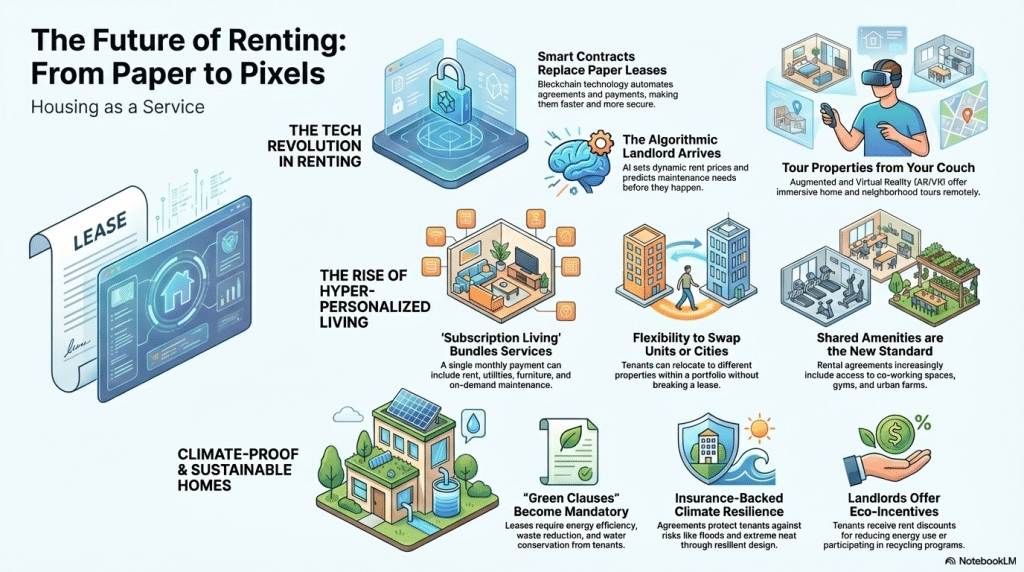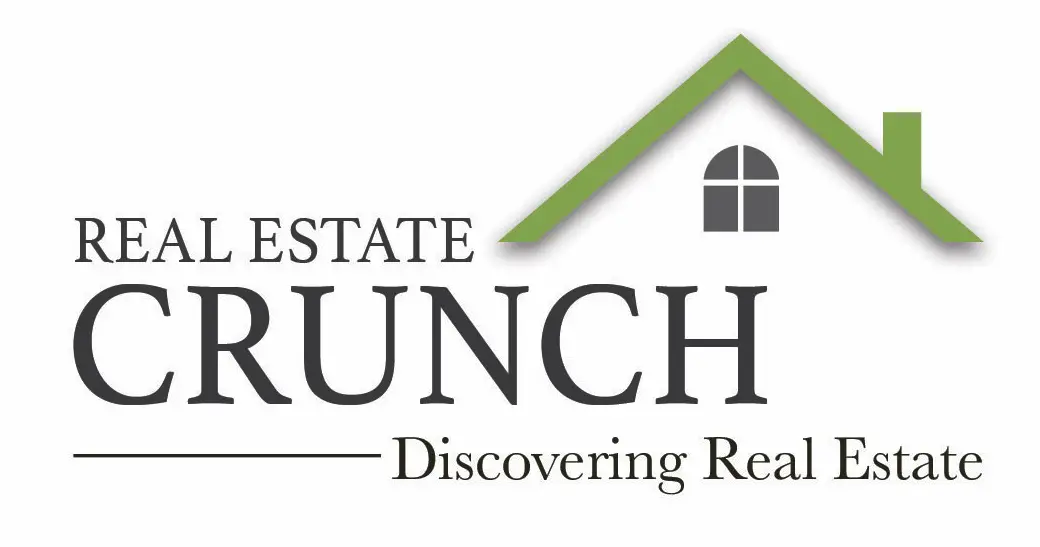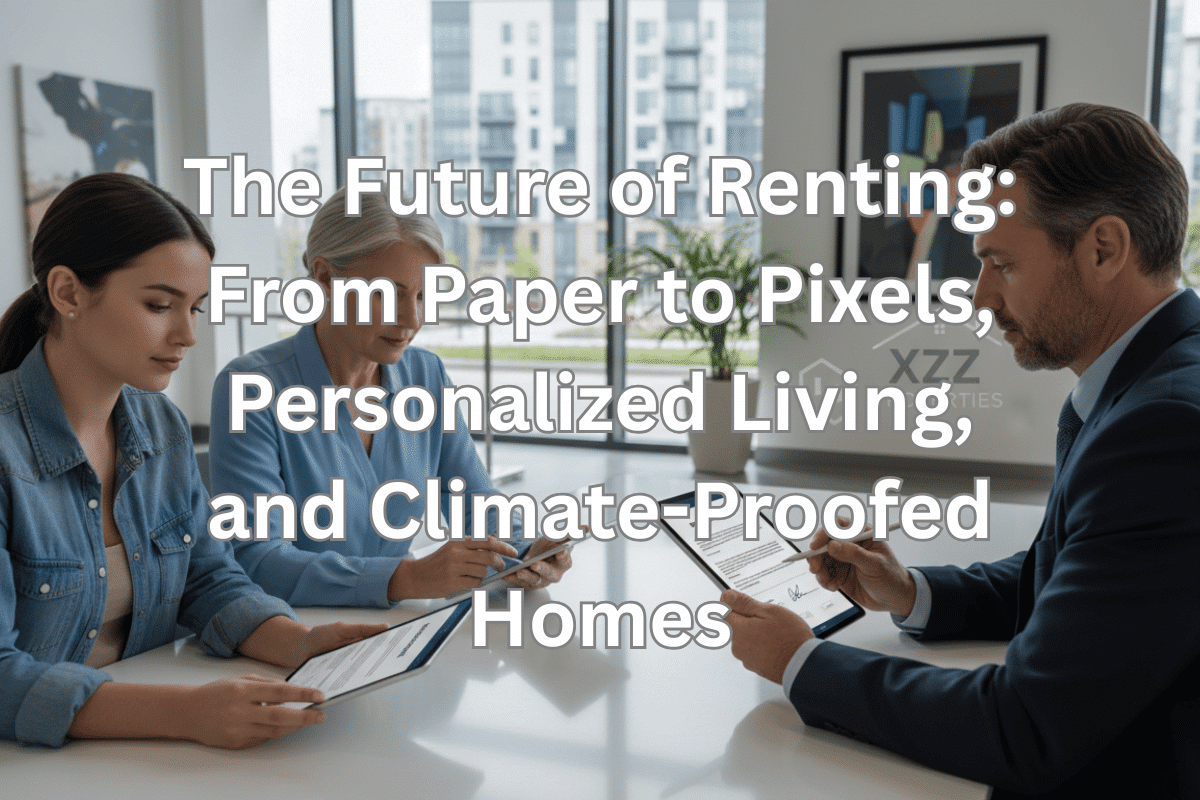The rental industry is undergoing a seismic shift, fueled by advancements in technology, changing tenant expectations, and the urgent need for sustainability. The future of renting is no longer about simply finding a place to live—it’s about creating hyper-personalized, flexible, and climate-conscious living experiences that align with modern lifestyles.
Read on as we’ll explore the key trends shaping the future of renting, from blockchain-powered smart contracts to AI-driven property management, subscription living, and sustainable housing. Let’s dive into the innovations that are redefining how we rent, live, and interact with our spaces.
Table of Contents
- The Disappearing Lease: From Paper to Pixels
- Hyper-Personalized Living: Beyond Four Walls
- Climate-Proofing Your Home: Green Clauses & Resilient Design
- The Algorithmic Landlord: AI, AR, and VR in Renting
- Future-Proofing Your Rental Strategy: What Now?
- Deep Dive Podcast
- Related Questions
The Disappearing Lease: From Paper to Pixels
The days of signing paper leases and mailing rent checks are quickly fading into history.
Thanks to blockchain technology and artificial intelligence (AI), the rental process is becoming faster, smarter, and more secure.
Smart Contracts on Blockchain for Instant, Secure Agreements
Blockchain technology is revolutionizing rental agreements with smart contracts—self-executing digital contracts that automate the leasing process. These contracts eliminate the need for intermediaries like brokers or lawyers, making transactions faster and more cost-effective.
With smart contracts, tenants and landlords can:
- Finalize agreements instantly and securely, with terms automatically enforced.
- Automate rent payments, ensuring timely transactions without manual intervention.
- Reduce disputes, as all terms are transparent and stored on an immutable ledger.
This shift to blockchain ensures greater trust between parties and streamlines the rental process, making it more efficient for everyone involved.

Dynamic Pricing and Shorter-Term Rentals Powered by AI
Artificial intelligence is changing how rents are set. Dynamic pricing models, already common in industries like hospitality and ride-sharing, are becoming the norm in real estate.
AI algorithms analyze market trends, demand, and property-specific factors to adjust rental rates in real-time.
This means:
- Tenants may see fluctuating rents based on seasonality or local demand.
- Shorter-term rentals, such as month-to-month leases, are becoming more accessible, offering flexibility for tenants who prioritize mobility.
While this system benefits landlords by maximizing revenue, it also gives tenants more options to find rentals that fit their budgets and timelines.
Personalized Rental Profiles Replacing Traditional Credit Checks
Traditional credit checks are being replaced by more comprehensive and personalized rental profiles. These profiles, powered by AI and big data, provide a holistic view of a tenant’s financial reliability and rental history.
A personalized rental profile can include:
- Payment history for previous rentals.
- Employment and income verification.
- Recommendations from past landlords.
- Behavioral insights, such as how consistently tenants pay bills or maintain properties.
This approach reduces bias and provides a fairer evaluation of tenants, especially for those with unconventional financial backgrounds, such as freelancers or gig workers.

Hyper-Personalized Living: Beyond Four Walls
Renting is no longer just about the unit itself—it’s about the lifestyle that comes with it. Modern tenants expect living arrangements that go beyond four walls, incorporating shared amenities, subscription-based services, and unparalleled flexibility.
Agreements Incorporating Access to Shared Amenities
The rise of co-living spaces has introduced a new standard for rental agreements. Tenants now expect access to shared amenities like:
- Co-working spaces for remote work.
- Urban farms for sustainable food production.
- Wellness facilities, including gyms, yoga studios, and meditation rooms.
These amenities foster a sense of community while catering to the diverse needs of modern tenants.
Subscription Living: Bundling Services for Convenience
Subscription living is transforming the rental experience by bundling services like utilities, maintenance, and even furniture into a single monthly payment. This model simplifies budgeting for tenants and offers landlords a competitive edge.
For example, a subscription rental might include:
- Fully furnished apartments with customizable furniture options.
- High-speed internet, electricity, and water bundled into the rent.
- On-demand maintenance services for repairs and upkeep.
This all-inclusive approach creates a hassle-free living experience, appealing to tenants who value convenience and simplicity.
Flexibility to Swap Units Within a Portfolio or City
Tenants are increasingly seeking flexibility in where they live. Some rental companies now offer agreements that allow tenants to swap units within a portfolio or even move to different cities without breaking their lease.
For instance:
- A tenant in New York could relocate to a sister property in Los Angeles under the same rental agreement.
- Tenants can upgrade or downsize their units as their needs change, such as moving from a studio to a two-bedroom apartment.
This flexibility caters to a transient, mobile workforce and aligns with the growing demand for adaptable living arrangements.

Climate-Proofing Your Home: Green Clauses & Resilient Design
The climate crisis is reshaping the rental market, with sustainability and resilience becoming top priorities for both tenants and landlords.
Mandatory Sustainability Clauses
Green clauses are becoming a standard feature in rental agreements. These clauses outline specific sustainability targets, such as:
- Energy efficiency requirements, like using LED lighting or Energy Star appliances.
- Waste reduction initiatives, including recycling programs and composting systems.
- Restrictions on water usage to conserve resources.
By incorporating these clauses, landlords can attract eco-conscious tenants while contributing to environmental goals.
Insurance-Backed Agreements for Climate Resilience
Climate resilience is no longer optional—it’s essential. Landlords are now offering insurance-backed agreements that protect tenants from climate-related risks, such as:
- Flood damage in high-risk areas.
- Extreme heat mitigation through energy-efficient cooling systems.
- Storm-proofing measures, like reinforced windows and roofs.
These agreements provide peace of mind for tenants and demonstrate a landlord’s commitment to long-term sustainability.
Incentives for Eco-Friendly Habits
To encourage sustainable living, some landlords are offering incentives for tenants who adopt eco-friendly habits. These might include:
- Discounts on rent for reducing energy consumption.
- Rewards for participating in recycling or composting programs.
- Subsidies for installing personal green initiatives, like solar panels or rainwater harvesting systems.
These incentives create a win-win situation, benefiting both the environment and the tenant’s wallet.

The Algorithmic Landlord: AI, AR, and VR in Renting
Technology is playing an increasingly central role in the rental experience, with AI, augmented reality (AR), and virtual reality (VR) transforming how properties are managed, marketed, and experienced.
AI-Powered Predictive Maintenance
AI is enabling landlords to anticipate and address maintenance issues before they become major problems. Predictive maintenance systems use sensors and data analytics to monitor the condition of a property in real-time.
For example:
- An AI system can detect when an HVAC system is about to fail and schedule repairs proactively.
- Smart water sensors can identify leaks before they cause significant damage.
This approach reduces downtime, lowers repair costs, and ensures a better living experience for tenants.
Augmented Reality for Virtual Property Tours
AR is revolutionizing how tenants view and interact with rental properties. With AR technology, tenants can:
- Take virtual property tours from the comfort of their homes.
- Visualize how furniture and decor will look in a space.
- Experiment with different layouts and designs before moving in.
This immersive experience makes the rental process more engaging and helps tenants make informed decisions.
VR Simulations for Experiencing Neighborhoods
Virtual reality is taking property tours to the next level by allowing tenants to experience the surrounding neighborhood and community amenities. Through VR simulations, tenants can:
- Explore nearby parks, restaurants, and entertainment venues.
- Get a feel for the local culture and lifestyle.
- Interact with virtual representations of shared amenities, like gyms and co-working spaces.
This technology helps tenants envision their lives in a new home, making the decision-making process more intuitive and enjoyable.
Future-Proofing Your Rental Strategy: What Now?
As the rental industry evolves, both tenants and landlords must adapt to stay ahead. Here’s how you can future-proof your rental strategy:
Advice for Tenants
- Build a Digital Rental Reputation: Maintain a strong rental history by paying rent on time, keeping properties well-maintained, and earning positive reviews from landlords.
- Understand Dynamic Pricing: Stay informed about how AI-driven pricing models work to secure the best deals.
- Embrace Flexibility: Look for rental agreements that offer mobility, such as the ability to swap units or cities.
Advice for Landlords
- Invest in Smart Home Tech: Enhance your properties with smart devices like thermostats, lighting, and security systems to attract tech-savvy tenants.
- Diversify Your Portfolio: Offer a mix of rental options, from short-term leases to subscription living, to cater to a wider audience.
- Focus on Sustainability: Incorporate green clauses and climate-resilient design to future-proof your properties and appeal to eco-conscious tenants.
The Rise of “Housing as a Service”
The concept of “housing as a service” is redefining the traditional landlord-tenant relationship. This model treats housing as a flexible, subscription-based service rather than a fixed asset.
For tenants, this means:
- Greater flexibility in where and how they live.
- Access to a wide range of bundled services and amenities.
For landlords, this means:
- New revenue streams from value-added services.
- A stronger focus on customer satisfaction and retention.
The future of renting is here, and it’s more dynamic, personalized, and sustainable than ever before. From blockchain-powered smart contracts to AI-driven pricing and climate-proofed housing, the rental industry is embracing innovation to meet the needs of modern tenants.
Whether you’re a tenant looking for flexibility and convenience or a landlord aiming to stay competitive in a rapidly changing market, the key to success lies in adapting to these emerging trends. By embracing technology, prioritizing sustainability, and rethinking traditional rental models, we can create a future where renting is not just a necessity but a truly transformative living experience.
Deep Dive Podcast
Learn more about this from ou Deep Dive Podcast.
Real Estate Crunch gives you real property and real estate information and advice. We offer a free monthly newsletter; you can sign up for our newsletter by clicking here.
We also have a weekly podcast called “Real Estate Crunch,” found on all major podcast platforms. Listen to our podcast by clicking here.
Follow us on our social media platforms – Facebook and Instagram.
Related Questions
Are All US Airports Federal Property?
Most US airports you and I will fly into are owned by the state or local governments and are run as a public utilities. Military airports would be owned and run by the Federal government’s Department of Defenses. Some smaller airports may be run by a private company or association.
By clicking here, you can read more about Are All US Airports Federal Property?.
Can You Legally Live In A Commercial Property?
You cannot live in a property that is zoned as a commercial property. Zoning laws in places like the United States are quite strict. They usually fall under the state and also county and municipality jurisdictions. To legally live in a commercial property, add to make that property your residence; it needs also be legally zoned as residential property or what is known as a mixed zone property.
By clicking here, you can read more about Can You Legally Live In A Commercial Property?.


Leave a Reply
You must be logged in to post a comment.